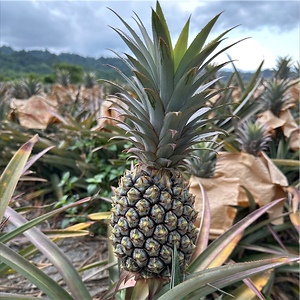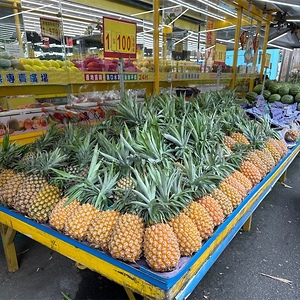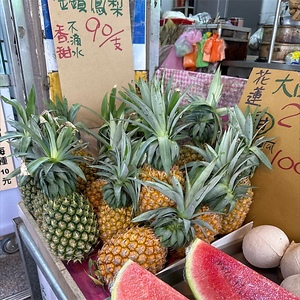


Taiwanese Golden Diamond Pineapples
Estimated Inventory, lb : 0
Description/Taste
Golden Diamond pineapples are a smaller varietal, averaging 15 to 17 centimeters in length and 10 to 12 centimeters in diameter, and have a cylindrical, slender, and straight head topped with a crown of upright, dark green leaves. The leaves are fibrous, pointed, and notably spineless. The fruits typically range around 1.4 kilograms in weight and are enveloped in a thin but tough rind. The rind transitions from green to golden yellow, orange, and brown hues as it ripens. The surface also showcases large, smooth, shallow eyes with textured patches and ridges. Each eye is clearly defined, and some have center pieces that point upward toward the leaves. Underneath the rind, the saturated, golden yellow flesh is soft, tender, aqueous, and succulent with low fiber. As the flesh ages, some brown spots may develop. The solid core in the center of the fruit is also edible, along with the flesh. Golden Diamond pineapples emit a fragrant, floral, honeyed, and tropical aroma. The variety is consumed raw once ripe and has a sweet, fruity, tangy, and subtly floral flavor, ranging from 14 to 20 degrees Brix combined with low acidity. Some consumers note a faint caramel or brown sugar undertone in the sugary, lingering
Seasons/Availability
Golden Diamond pineapples are typically available year-round, with a peak season from March through June. Each growing region will have varying harvest dates, depending on the area’s climate combined with seasonal weather changes.
Current Facts
Golden Diamond pineapples, botanically classified as Ananas comosus, are a Taiwanese variety belonging to the Bromeliaceae family. Pineapples are often considered Taiwan’s national fruit and there are over 90 varieties grown on the island. Of the many different varieties, Golden Diamond pineapples are the most commercially dominant cultivar, accounting for 85 to 90% of the commercially produced fruits. Golden Diamond pineapples are a Tainong, also known as Tainung variety, meaning they were a variety developed through a national breeding program. The official varietal name is Tainong No. 17, and the variety is sometimes labeled as Spring Honey pineapple in local markets for its sweet, honeyed flavor. Golden Diamond pineapples are the most exported variety from Taiwan, primarily being sent to Japan, Singapore, and other countries in Asia. The fruits are cultivated year-round as a premium cultivar and are sometimes individually bagged by hand on the plant to protect the fruit’s surface from burning during warm sunny months. Since their release in the late 20th century, Golden Diamond pineapples are widespread throughout Taiwan and are favored as a variety for everyday home use and as a specialty gift for celebratory occasions. This versatility leads them to be prominently displayed in local markets and the fruits are sold fresh, sliced, and dried in various sweets and confections.
Nutritional Value
Golden Diamond pineapples have not been extensively studied for their nutritional properties. Pineapples, in general, are a source of vitamin C to strengthen the immune system, calcium to protect bones and teeth, potassium to balance fluid levels within the body, and fiber to regulate the digestive tract. Pineapples also provide magnesium to control nerve functions, phosphorus to help build genetic material such as DNA and RNA, vitamin A to maintain healthy organs, and other nutrients, including B vitamins, iron, zinc, copper, and folate. In Traditional Chinese Medicine, pineapples are believed to stimulate the digestive tract and enzymes within the flesh can help dissolve proteins. These enzymes may also cause some irritation in the mount. In Taiwan, there is a saying that pineapples can sometimes “bite your tongue” or “bite back” if eaten in excess quantities. This saying is derived from the fruit’s bromelain content. Bromelain is a combination of enzymes found in the fruit’s flesh that have the ability to digest proteins. Despite this feeling, bromelain is believed to have anti-inflammatory and pain-relieving properties. Pineapples are also viewed as a method to cure heatstroke and the juice is combined with salt to make a natural electrolyte-type drink.
Applications
Golden Diamond pineapples have a sweet, tropical taste suited for fresh and cooked preparations. The variety is known for its tender flesh and is typically enjoyed out of hand as a refreshing snack. Golden Diamond pineapples have a thin rind that can be cut away, and both the flesh and the core are edible. The core will have a crunchier, firmer consistency, while the flesh will be softer and juicier. In addition to consuming as a stand-alone snack or dessert, Golden Diamond pineapples can be chopped and tossed into green salads, finely diced and used as a topping, or sliced and served on fruit platters with nuts, cheeses, and other bite-sized items. Golden Diamond pineapples are also popularly infused into juices, smoothies, cocktails, wines, and other beverages. In Taiwan, it is common for pineapple juice to be added as flavoring in vinegars as a cooking ingredient and mixed with water as a digestif. The fruit can also be lightly cooked in stir-fries, added to rice-based dishes, chopped into sausages, or sliced and cooked on pizza. Golden Diamond pineapples have a tropical flavor suited for jam, jelly, and marmalade production. The flesh can also be used to flavor popsicles, sorbets, shaved ice dishes, ice cream, tarts, cakes, and other baked goods. Beyond fresh uses, the flesh can be dried into chewy pieces and consumed as a snack. Golden Diamond pineapples pair well with other fruits such as bananas, oranges, passionfruit, mangoes, and coconut, dark chocolate, vanilla, brown sugar, and mint. Whole, unopened Golden Diamond pineapples will keep for a few weeks when stored at room temperature. Once ripe and sliced open, pieces of the flesh should be stored in a container in the refrigerator.
Ethnic/Cultural Info
Pineapples are a revered gift for bringing good fortune in Taiwan. The Hokkien dialect of Taiwanese pronounces the word pineapple as “ong-lai,” and the sound of this word is believed to sound similarly to a word or phrase used to describe the “arrival of prosperity or good fortune.” Gifting pineapples is believed to bless the receiver, and the golden coloring of yellow-fleshed varieties, like Golden Diamond, is also believed to be auspicious, resembling the color of gold coins or money. The practice of pineapple gifting has evolved over time in Taiwan and one of the most famous pineapple-centric creations was the pineapple cake. These small confections are typically sold in square, rectangular, round, or pineapple-like shapes and have a flaky exterior similar to a shortbread or scone, enveloping a sticky, paste-filled interior. The filling is traditionally a mix of pineapple and winter melon, as the winter melon helps to create a smoother, less fibrous consistency. Pineapple cakes rose in popularity around the 1930s with the boom in pineapple canning in Taiwan. The industry was heavily influenced by the Japanese, who were running the canning industry on the island, and eventual fruit surpluses led pastry chefs to create the buttery, sweet, and tangy treats. In the modern day, pineapple cakes are sold across Taiwan in gift shops, high end department stores, farm shops, bakeries, and cafes. The cakes are a popular gift for special occasions, tourists, and are even served as wedding desserts. Each company that produces pineapple cakes has their own secret recipe, and the culture surrounding the cakes is a feeling of community. Pineapple cakes are given as gifts, but it is customary for the receiver to cut up and share the cakes to spread the happiness gained from eating the tropical sweets.
Geography/History
Golden Diamond pineapples are native to Taiwan and were developed in the late 20th century. Pineapples, in general, were introduced to Taiwan from China during the Qing Dynasty, beginning in 1644 CE. Later, during Japanese Colonization from 1895 to 1945, additional pineapple varieties were introduced into Taiwan for canning purposes and for experimental farms to test new tropical plants. At the time, canning was a new method of preservation for various meats, fruits, and vegetables and was viewed as an important business to supply food to soldiers during wars. Pineapple canning began in Taiwan in 1900, which quickly led to the establishment of pineapple farms across the island. The fame of canning lasted throughout the early part of the century, but with the government later taking control and seizing the pineapple canning industry in the 1930s, pineapple growers began to search for varieties they could grow for fresh markets versus canning. Agricultural breeding institutions began crossbreeding new pineapple varieties to create improved fruits. Hawaiian pineapple varieties were introduced in the 1970s for breeding purposes, and by the 1980s, agricultural institutions across the island were successfully creating new cultivars that were labeled a part of the Tainong series. Golden Diamond pineapples were created in 1989 at the Chiayi Branch of the Agricultural Experimental Institute of the Council of Agriculture and were officially released in 1998. The variety was initially known as Tainong No. 17 and was later branded under the commercial name Golden Diamond. Today, Golden Diamond pineapples are commercially produced throughout Taiwan with the primary production regions including Kaohsiung, Chiayi, Pingtung, Nantou, and Tainan. The fruits are sold locally in fresh markets and neighborhood grocers and are also exported to countries worldwide, mainly Japan and other regions of Asia.












